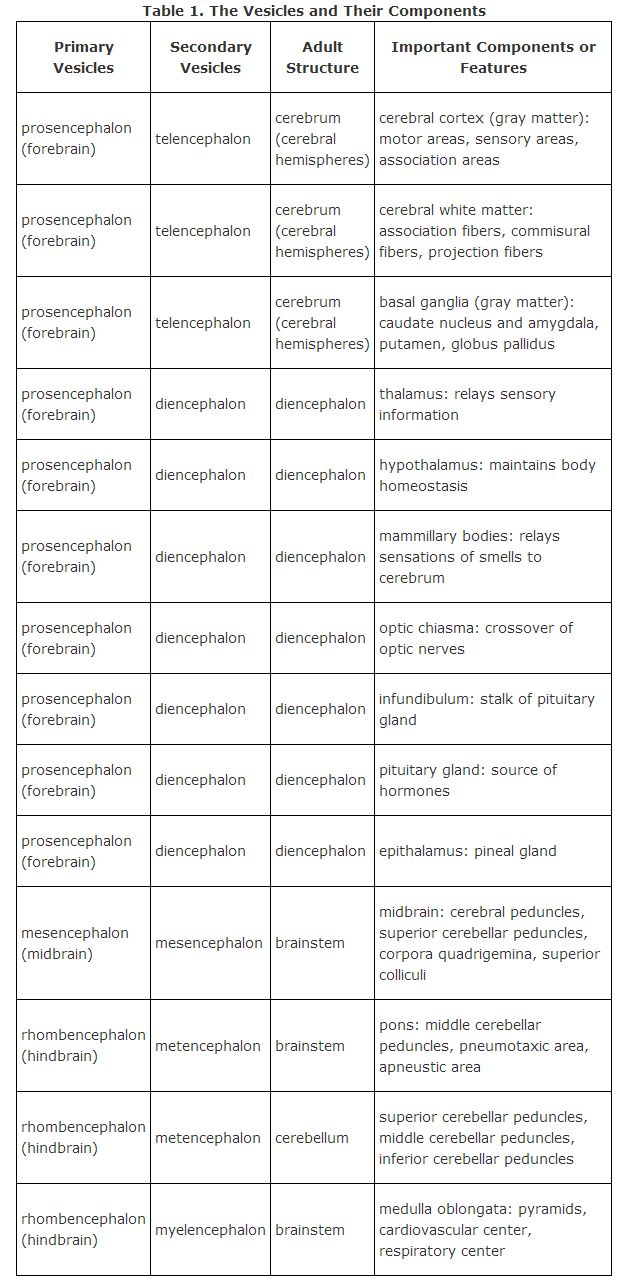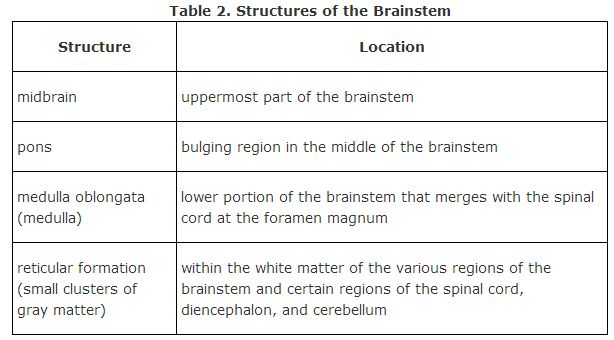Three cavities, called the primary brain vesicles, form during the early embryonic development of the brain. These are the forebrain (prosencephalon), the midbrain (mesencephalon), and the hindbrain(rhombencephalon).
During subsequent development, the three primary brain vesicles develop into five secondary brain vesicles. The names of these vesicles and the major adult structures that develop from the vesicles follow (see Table 1):
-
The telencephalon generates the cerebrum (which contains the cerebral cortex, white matter, and basal ganglia).
-
The diencephalon generates the thalamus, hypothalamus, and pineal gland.
-
The mesencephalon generates the midbrain portion of the brainstem.
-
The metencephalon generates the pons portion of the brainstem and the cerebellum.
-
The myelencephalon generates the medulla oblongata portion of the brainstem.
The cerebrum consists of two cerebral hemispheres connected by a bundle of nerve fibers, the corpus callosum. The largest and most visible part of the brain, the cerebrum, appears as folded ridges and grooves, called convolutions. The following terms are used to describe the convolutions:
-
A gyrus (plural, gyri) is an elevated ridge.
-
A sulcus (plural, sulci) is a shallow groove.
-
A fissure is a deep groove.
The deeper fissures divide the cerebrum into five lobes (see Figure 1; most lobes are named after bordering skull bones): the frontal lobe, the parietal lobe, the temporal lobe, the occipital lobe, and the insula. All but the insula are visible from the outside surface of the brain.
A cross section of the cerebrum shows three distinct layers of nervous tissue (see the list below and Figure 2):
-
The cerebral cortex is a thin outer layer of gray matter. Such activities as speech, evaluation of stimuli, conscious thinking, and control of skeletal muscles occur here. These activities are grouped into motor areas, sensory areas, and association areas.
-
The cerebral white matter underlies the cerebral cortex. It contains mostly myelinated axons that connect cerebral hemispheres (commissural fibers), connect gyri within hemispheres (association fibers), or connect the cerebrum to the spinal cord (projection fibers). The corpus callosum is a major assemblage of commissural fibers that forms a nerve tract that connects the two cerebral hemispheres.
-
Basal ganglia (basal nuclei) are several pockets of gray matter located deep inside the cerebral white matter. The major regions in the basal ganglia—the caudate nuclei, the putamen, and the globus pallidus—are involved in relaying and modifying nerve impulses passing from the cerebral cortex to the spinal cord. Arm swinging while walking, for example, is controlled here.
- The diencephalon connects the cerebrum to the brainstem. It consists of the following major regions:
-
The thalamus is a relay station for sensory nerve impulses traveling from the spinal cord to the cerebrum. Some nerve impulses are sorted and grouped here before being transmitted to the cerebrum. Certain sensations, such as pain, pressure, and sensitivity to temperature, are also evaluated here.
-
The epithalamus contains the pineal gland. The pineal gland secretes melatonin, a hormone that helps regulate the biological clock (sleep‐wake cycles).
-
The hypothalamus regulates numerous important body activities. It controls the autonomic nervous system and regulates emotion, behavior, hunger, thirst, body temperature, and the biological clock. It also produces two hormones (antidiuretic hormone or ADH, and oxytocin) and various releasing hormones that control hormone production in the anterior pituitary gland.
The following structures are either included or associated with the hypothalamus:
-
The mammillary bodies relay information related to eating, such as chewing and swallowing.
-
The infundibulum connects the pituitary gland to the hypothalamus.
-
The optic chiasma passes between the hypothalamus and the pituitary gland. Here, portions of the optic nerve from each eye cross over to the cerebral hemisphere on the opposite side.
- The brainstem connects the diencephalon to the spinal cord. The brainstem resembles the spinal cord in that both consist of white matter fiber tracts surrounding a core of gray matter. The brainstem consists of the following four regions, all of which provide connections between various parts of the brain and between the brain and the spinal cord. (Some prominent structures of the brainstem regions are listed in Table 2 and illustrated in Figure 3, which also illustrates the relationship of the cranial nerves to the brainstem.)

Figure 1. Anatomy of the adult brain.

Figure 2. The cerebral cortex and basal ganglia.
.
 Figure 3. Prominent structures of the brainstem.
Figure 3. Prominent structures of the brainstem.
The reticular activation system (RAS), one component of the reticular formation, is responsible for maintaining wakefulness and alertness and for filtering out unimportant sensory information. Other components of the reticular formation are responsible for maintaining muscle tone and regulating visceral motor muscles.
The cerebellum consists of a central region (the vermis) and two winglike lobes (the cerebellar hemispheres). Like that of the cerebrum, the surface of the cerebellum is convoluted, but the gyri, called folia, are parallel and give a pleated appearance. The cerebellum evaluates and coordinates motor movements by comparing actual skeletal movements to the movement that was intended.
The limbic system is a network of neurons that extends over a wide range of areas of the brain. The limbic system imposes an emotional aspect to behaviors, experiences, and memories. Emotions such as pleasure, fear, anger, sorrow, and affection are imparted to events and experiences. The limbic system accomplishes this by a system of fiber tracts (white matter) and gray matter that pervades the diencephalon and encircles the inside border of the cerebrum. The following components are also illustrated in Figure 4:
The hippocampus (located in the temporal lobes of the cerebral hemispheres)
The dentate gyrus (located in the cerebral hemisphere, within the hippocampus)
The amygdala or amygdaloid body (an almond‐shaped body associated with the caudate nucleus of the basal ganglia)
The mammillary bodies
The anterior thalamic nuclei (in the thalamus)
The fornix (a bundle of fiber tracts that links components of the limbic system)
Figure 4. Features of the limbic system.

